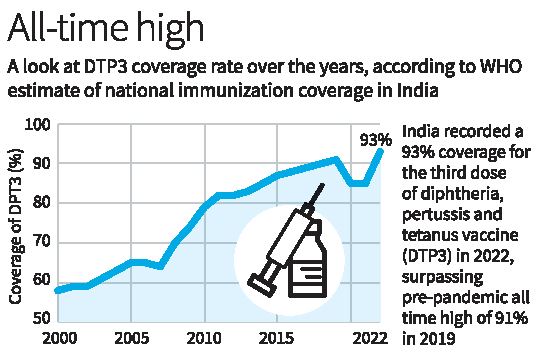A Record 93% DPT3 Immunisation Coverage in 2022: WHO
Context
The World Health Organization (WHO) reports that the coverage rate for DPT3, or the third dose of diphtheria, pertussis, and tetanus vaccine, reached an all-time high of 93% in India in 2022, surpassing the previous pre-pandemic best of 91% recorded in 2019 and also marking a significant increase from the 85% recorded in 2021.
What is DPT Vaccine and what is it used for?
- DPT Vaccine: The DPT vaccine, sometimes known as the triple vaccine, protects against tetanus, diphtheria, and pertussis (whooping cough).
- Components: The diphtheria and tetanus toxoids, which are inactivated toxins produced by the corresponding infections, are contained in the DPT vaccine. Additionally, it contains pertussis antigens or dead entire cells of the bacterium that causes the disease.
- Targeted immune response: Immune response that is specifically focused against the toxins generated by diphtheria, tetanus, and the pertussis bacterium are developed as a result of the DPT vaccine. The body can recognize and combat these viruses more successfully if exposed in the future because of this focused response.
- Importance of vaccination: The DPT vaccine is essential for preventing these fatal infectious diseases and safeguarding the public’s health. Herd immunity is ensured and helps lower the likelihood of outbreaks, protecting people who cannot get immunized, such as those with certain medical conditions or allergies.
What are the findings according to immunisation coverage for 2022 by WHO?
- DPT3 Coverage in India:
-
-
- India attained an all-time high coverage rate of 93% for the third dose of the diphtheria, pertussis, and tetanus vaccinations (DPT3) in 2022.
- This percentage was higher than the pre-pandemic best of 91% that was obtained in 2019, demonstrating the considerable advancements made in immunization campaigns throughout and after the COVID-19 pandemic.
- The improvement from the 85% coverage achieved in 2021 demonstrates that the immunization rates were successfully improved.
-
- DPT3 Coverage in the WHO South-East Asia Region:
-
-
- According to estimates from the World Health Organization (WHO) and UNICEF, DPT3 coverage will reach its pre-pandemic level of 91% in the WHO South-East Asia Region by 2022.
- This demonstrated a striking improvement from the 82% coverage noted in 2021, demonstrating a strong trend in the region’s vaccination efforts.
-
- Measles Vaccine Coverage:
-
-
- From 86% in 2021 to 92% in 2022, there was a 6% increase in measles vaccination coverage in the WHO South-East Asia Region.
- This demonstrates efforts to safeguard kids against measles, a highly contagious and potentially dangerous illness.
-
- Reduction in Children Without Even One Dose:
-
-
- By 2022, fewer kids were living without even one dose of the DPT vaccine.
- There were 2.3 million fewer zero-dose children in 2022 than there were in 2021, a sign that vulnerable and unvaccinated populations are being reached.
-
- Reduction in the Number of Partially Vaccinated Children:
-
-
- In 2022, there was a reduction in the number of partially immunized children (those who got at least one dose of the DPT vaccine but did not finish the primary series of three doses).
- The number of children who had only a partial immunization decreased from 1.3 million in 2021 to 6.5 lakh (650,000) in 2022 as a result of greater efforts to ensure full vaccination.
-
- Leaders in Immunization Recovery:
-
-
- Of all the WHO areas, the South-East Asia region stood out as having the best immunization recovery rates.
- This accomplishment is partly because of the efforts made by nations like Indonesia and India to increase immunization rates and coverage.
-
- Other Country Coverage Rates:
-
- The DPT3 coverage rate for Indonesia was estimated to be 85% in 2022, which is the same as in 2019 but much higher than the 67% noted in 2021.
- With outstanding coverage rates of 98% and 99%, respectively, Bhutan and the Maldives outperformed their pre-pandemic rates.
- With coverage rates of 98% and 97%, respectively, Bangladesh and Thailand demonstrated consistent regular immunization coverage throughout the COVID-19 epidemic and beyond.
The overall report highlights the value of routine immunization programs in defending kids against fatal illnesses and highlights the advancements made in the area despite the difficulties brought on by the COVID-19 epidemic. It urges sustained efforts to ensure the health and wellbeing of every child through immunization programs.





